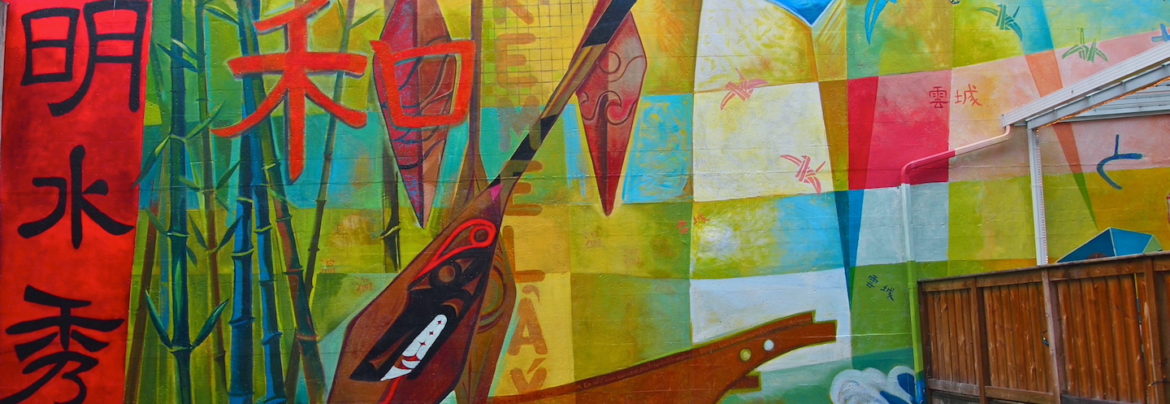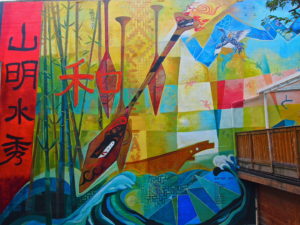Forgotten Histories: OURO Collective researches Vancouver spaces - Vancouver Ballet Society
- Home
- Features 2020 - 2023
- Forgotten Histories: OURO Collective researches Vancouver spaces

By Rachel Silver Maddock
Vancouver’s OURO Collective is a truly collaborative venture. Each dancer (there are currently five) inputs expertise from their main styles, which include hip-hop, waacking, breaking, popping and contemporary dance, to create group choreography. The result is visually arresting movement in which the viewer’s eye is guided from one formation to the next as bodies snake around each other, split off and regather in unexpected ways.
This creation model has served OURO well over the past seven years, during which they have carved out a distinct presence that goes beyond their home city. Whether onstage, on film or on social media, they put forward fresh, engaging content, and collaborate often with artists of different mediums.

When the pandemic hit in Spring 2020, OURO was busy. Cristina Bucci, one of the founding members, says in those first months of lockdown the group was just trying to find ways to keep the momentum going. In fact, the slow-down provided an unexpected blessing: core members Bucci, Maiko Miyauchi and Rina Pellerin had time to recalibrate and apply for new and different opportunities they normally would have been too busy to search out.
One opportunity was Dance Victoria’s Chrystal Dance Prize, which the group was awarded last summer. The prize provided funding to work with Los Angeles-based dance artist RubberLegz (Rauf Yasit) on a new full-length piece, something OURO has wanted to do for several years. Since last December, they’ve rehearsed remotely, with the OURO cast in a strict “bubble” in-person, and RubberLegz, the choreographer, on Zoom. The hybrid rehearsals, according to Miyauchi, have been “surprisingly” successful, with RubberLegz setting intricate choreography on the dancers.
In their own collaboratively choreographed work, OURO continues to develop a series they began in 2019 investigating Vancouver neighbourhoods. The series continues with SOTTO 51 and Fire06, both premiering this year. These works explore the often forgotten histories of local areas, in the case of SOTTO 51, the popular sub-surface street-dance hub of Robson Square in downtown Vancouver. The name is a bit of word play: Robson Square is the City of Vancouver’s Block 51, and sotto means “under” in Italian (a nod to Bucci’s family background).
OURO’s purpose for exposing forgotten histories is to combat the “cultural amnesia” that occurs in transient urban landscapes. SOTTO 51 has had several phases of research, starting with collective members simply dancing at Robson Square to see how that influences their movement. Other phases have included learning about the architecture of the area, the history of how people have used the square for protests and gatherings, and the Indigenous, Chinese and Japanese history of the place.
In keeping with their collaborative ethos, the collective engaged artists of other mediums to build a unique visual identity for SOTTO 51 — including 3D glass shapes within photographs of the dancers (by digital artist Abhishek Joshi) and a custom type design for the title (by designer Abi Huynh). OURO has used this eye-catching digital content to form a sort of brand around the show, both to promote it on social media and through merchandise, such as SOTTO 51 tote bags.

“When you look around Vancouver there are so many talented people,” says Miyauchi. “We wanted to collaborate with these widely known local artists. And the visual content they make brings us [dancers] more inspiration.”
Fire06, a quintet, was created for the upcoming Dancing on the Edge Festival July 8-17, and is one of seven COVID Commissions offered by the festival. In this piece, OURO turns their attention to the Firehall Arts Centre, the festival’s headquarters in Vancouver’s Downtown Eastside, one of the city’s oldest neighbourhoods, and a former fire station built in 1906 (hence the name). OURO are approaching the work similarly to their piece in Robson Square — trying to first learn and understand the social history of the Firehall and the culturally complex surrounding area, and then to celebrate it.
Miyauchi says that interviews with residents who know the history of the area have been invaluable. For her, being grounded in their words “creates a feeling that affects your movement.”
“The Strathcona area has always been a place where newcomers to Canada have gravitated,” says Donna Spencer, artistic producer of the festival and a resource during OURO’s research process. “It includes the historical districts for Japanese and Chinese Canadians. And the Firehall site used to be a meeting place for different First Nations, who would pick walnuts from the trees that were here and use the fishing ground.”
Focusing on the Firehall is a bit personal for OURO, who received support in their very first two seasons as a collective from Spencer through Firehall programming. Bucci says now, in their seventh season, it’s time to “come full circle and revisit the site where we kind of began.”
Fire06 will be presented as a work-in-progress on the Firehall’s Courtyard Stage July 8 and 11.

